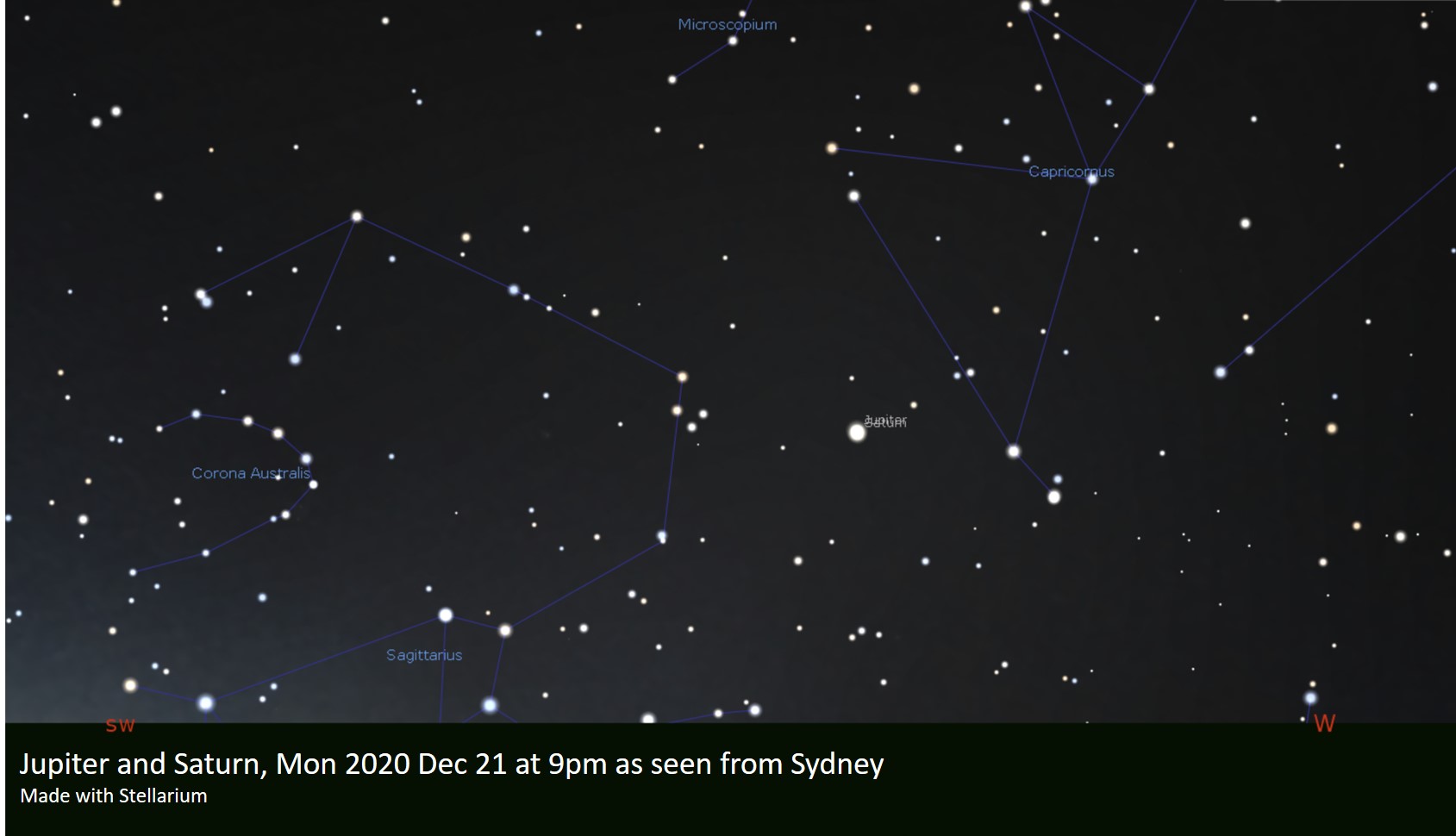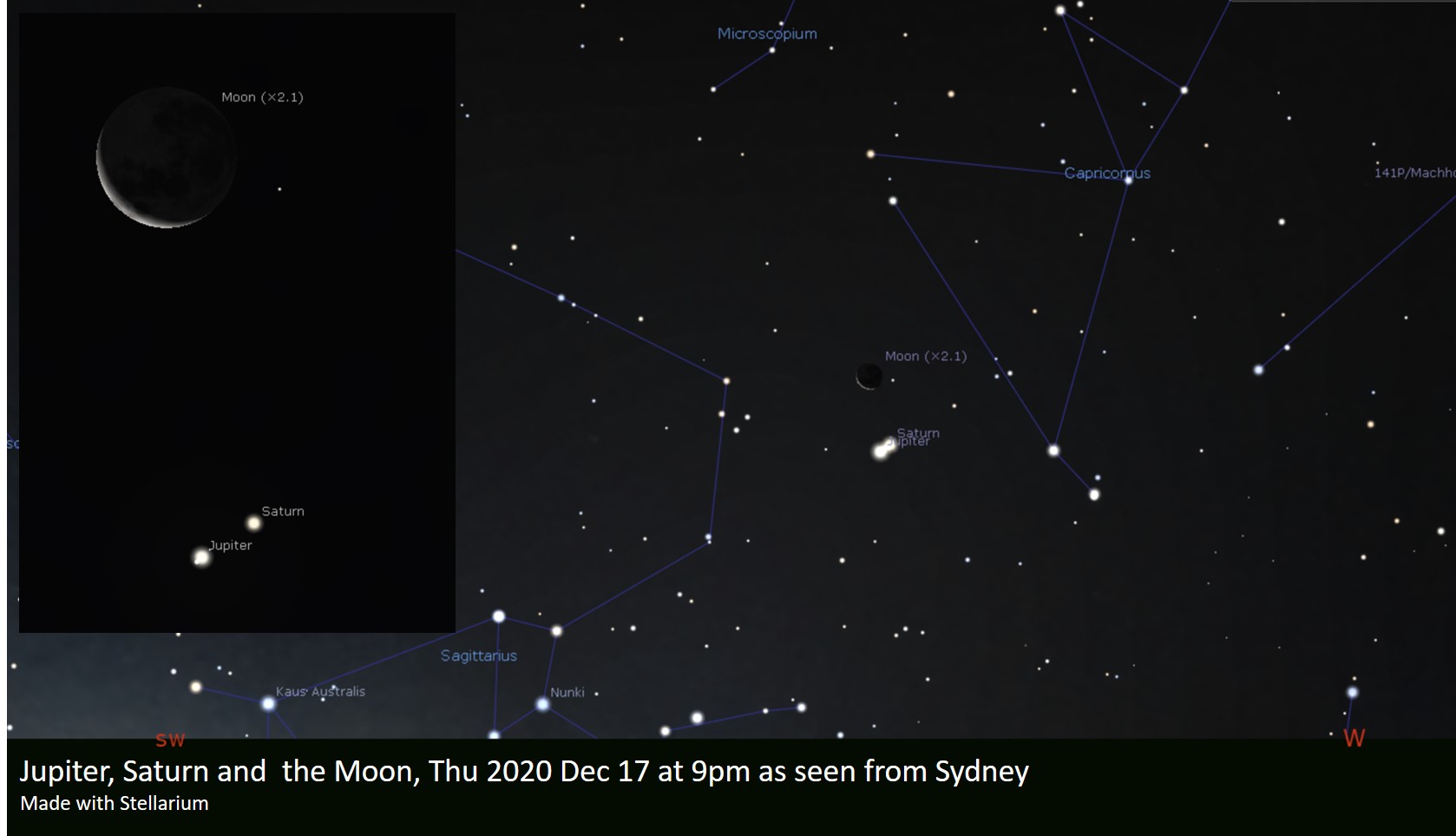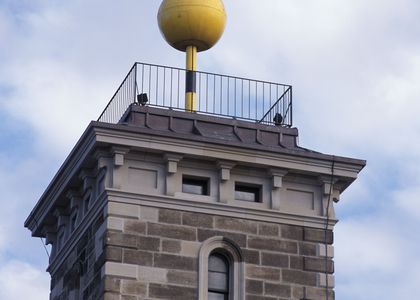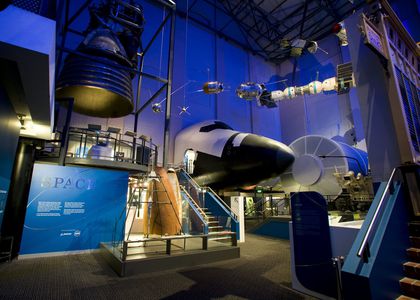
This year has been a bit different for us all and horrific for many. One thing that keeps me feeling positive is knowing that the sky simply carries on with its own steady cycles, presenting us from time to time with heartwarming spectacles that distract us for a little while.
What are Jupiter & Saturn doing?
The year 2020 ends with a rare close meeting, or conjunction, between Jupiter & Saturn. The orbital periods (years) of the two planets mean they pass close to each other every 20 years. But the different tilts of their orbits mean this year they pass closer than at any time in almost 400 years. They will be just 6.1-arcminutes from each other – that is one fifth the width of the Full Moon*.
And that is close enough that they can be seen side by side through a telescope – a very rare sight.
At Sydney Observatory we often view these planets but I’m looking forward to seeing them together to compare their respective sizes, colours and features.
Of course, the two planets are actually many millions of kilometres apart, with Saturn almost twice as far from us as Jupiter. They just appear close from our point of view.
When & Where should I look?
All this year, while we’ve been busy with masks, handwashing and physical distancing Jupiter & Saturn have been steadily closing in on each other. Both planets are easily visible by eye, but binoculars or a telescope of any kind, will enhance your view.

On December 17 the full show begins. After sunset, as twilight fades, look towards the western horizon for two bright ‘stars’. You will need a clear, unobstructed view as this is all happening very close to the horizon. Find a hill, a large open space or a west-facing shoreline.
Jupiter and Saturn will be just a Moon-width apart on December 17 and already visible together through a telescope using a low power eyepiece. Jupiter is the brighter of the two planets. Just above them, looking by eye now, is the crescent Moon itself. A very pleasing trio.
On the night of Monday-Tuesday December 21-22 (for Australia) they are at their closest – and higher magnifications can be used. The few nights before and after this are also good.
Now you can compare these two giant planets: by eye can you see one point of light or two; by telescope how does their size compare; do their colours (subtle as they are) differ; which planet shows more detailed cloud patterns; how many moons can you see?
As Christmas arrives Jupiter and Saturn have moved apart and they’ll go their own way from then until 2040.
How rare is this?
Jupiter & Saturn pass each other in the sky every 20 years. Last time they passed this close (one-fifth the Moon’s diameter apart) was in 1623, only shortly after the telescope was invented. They will next be this close in 2080. After that they never get this close again in the next thousand years.
As best as I can determine it appears that Jupiter & Saturn get this close (0.1-degrees) about once every 600 years. And they get closer than the width of the Full Moon (0.5-degrees) about once every 80 years (roughly). So, if you are over 20 years old this might be a once in a lifetime event. Otherwise you might just see this once again in 2080!
In 2040, by the way, they are about three Moon-widths apart.
How can I avoid clouds to see this?
It’s presently impossible to accurately predict where clouds will be. The best I can suggest is to keep an eye on the longer-range forecasts at the BOM, the BOM’s four-day forecast maps and their MetEye forecasts. There are also cloud-forecasting sites that may help: SkippySky and Cloud Free Night.
Just what is a conjunction exactly? And why do I see different predictions?
This gets a bit technical – you may prefer to just head outside and enjoy the free show!
A ‘conjunction’ is often simply defined as any close pairing of two celestial objects, perhaps two planets or the Moon and the Sun.
However, it is sometimes defined more strictly to mean the two celestial objects have the same longitude coordinate (astronomers call this their Right Ascension) in the sky, and we call this a ‘conjunction in Right Ascension’.
Another term, rarely used, is ‘appulse’, and this refers to the minimum separation of two celestial objects, regardless of their Right Ascension.
A conjunction in Right Ascension can (almost) never occur at the same time as an appulse. And the separation at an appulse is always smaller than at the conjunction in Right Ascension. Usually, they occur several days apart (at least for Jupiter and Saturn) but this years’ appulse is so close both occur on the same night.
On Dec 21-22 the conjunction (in Right Ascension) occurs at about midnight AEDT, and the appulse occurs at around 5:15am AEDT. For Australian locations, except the western parts of Western Australia, both planets will have set. I can’t give more precise times than this because it varies slightly (a few minutes) by location, and each program I use defines the planetary orbits in slightly different ways – different input, different output. But that’s a complication, involving ‘ephemerides’, for another time.
*The Moon is just half a degree, or 30-arcminutes, wide.


